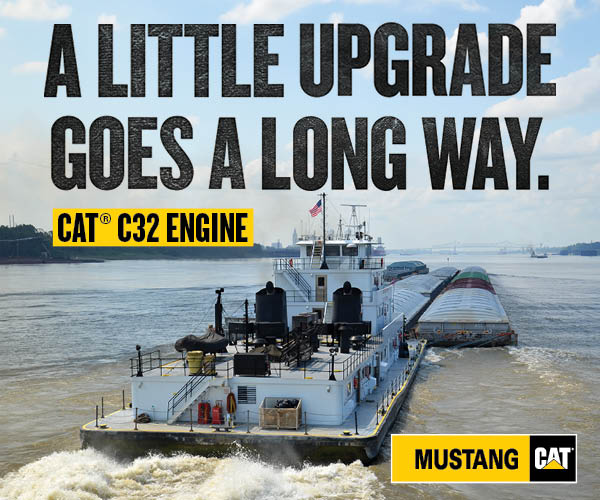More than six months after the closure of Wilson Lock’s main chamber, ports, shippers, fleeting services, linehaul operations and other river-related businesses say it is costing them. In some cases, they’re reporting layoffs, business slowdowns and concerns over whether customers will switch transportation modes now or in the future.
Wilson Lock, Tennessee River Mile 259.4 In Florence, Ala., closed September 25 after operators reported hearing popping noises. Inspections later showed cracking of the lower miter gates and pintle assemblies, which are essentially the hinges on which the gates swing open and closed. That cracking forced the closure until weld repairs, bracing and newly machined pintles can be put in place. Earlier this month, the Corps of Engineers announced the repairs are expected to cost $18 million.
High Water Delays
The chamber is scheduled to reopen June 14, although the Nashville Engineer District said in an industry call April 15 that there could be a delay. That’s because heavy rainfall the previous week caused elevated tailwater levels, forcing the Corps to evacuate people and equipment and rewater the chamber to decrease the pressure on it. Prior to the rainfall, the Corps had already used five of the seven adverse weather contingency days that were built into the repair schedule.
Brian Mangrum, chief of the Nashville District’s technical support branch, said crews were able to begin pumping out the chamber April 10, with the water level beginning to recede the next day. They returned equipment to the chamber over the weekend and resumed work April 14.
Gate support mounting pads were grouted into place after epoxy cured on the chamber’s floor bolts, and diagonal bracing has been welded into place; however, gate support installation work ran into unanticipated challenges because of site conditions, and field modifications were required in some cases, Mangrum said.
Jack placement under the gates began on April 15, with gate lifting anticipated to commence later in the week. Once the gates are lifted, the team will begin removing the damaged pintle assemblies. The TVA Power Services Shop needs the old pintles to complete final machining on the new ones that are to be installed.
Mangrum said the Corps will notify industry as quickly as possible of any delays to the planned reopening schedule.
“At this time we’re still closely reviewing all those remaining work activities to assess the impacts of the delays that we experienced there,” he said.
Cost To Industry
While the main lock chamber is closed, tows are transiting the 100-year-old, two-step auxiliary chamber, which can fit one standard-sized barge at a time. This has led to exceedingly long wait times.
Scot Cornelius, manager of business development for Rogers Group, a construction aggregate business, said the lock closure has led to a business slowdown.
“It’s obviously created reduced sales and volumes at our river production facility,” he said.
To prevent layoffs, he said the company has had to come up with creative ways to keep crews employed. Some have been sent to out-of-state operations, but that requires keeping them in motels, away from their families and paying employees a per diem rate.
Cornelius took care not to cast blame on the Corps of Engineers, which he believes is working to complete the repairs safely and as quickly as its procedures allow.
“I think they’re working hard at it to get it done, but it’s just taking a really long time, and it’s just killing everybody,” he said.
Cornelius pulled up lock queue data showing that, as of the morning of April 15, 34 towboats and several pleasure boats were waiting their turn to transit the auxiliary lock. The most recent towboat to transit the lock spent 18 days waiting to lock downriver with a tow. That same boat could spend another 18 days coming back upriver with empty barges, Cornelius said. He estimated the cost of that kind of delay to be $200,000 to $400,000 per tow on top of typical shipping costs.
“This has cost millions and millions of dollars,” he said.
Rick Terry, president of Alliance Sand and Aggregates in Decatur, Ala., said when Wilson closed the company at first tried to deal with delays. Its first tow made it through in four days. The second took eight days.
“I thought that was just ridiculous,” he said. “That’s a piece of cake now.”
Eventually, he said, the cost of barging sand rose so much that it was impossible to pass it on to customers. Instead of having products available in the north Alabama cities of Florence, Huntsville and Decatur, all the company’s sand is being unloaded at its Florence facility.
“They’ve got to truck all the way from Huntsville or Decatur all the way to Florence to get sand,” Terry said of customers.
That takes at least two to three hours roundtrip.
“We like to go where the customer is, and the customers like it, too,” Terry said.
Currently, though, that’s not possible.
Alliance reached a deal for a long-term lease of Decatur-Morgan County Port Authority property (commonly known as the Alabama state docks) in June, which went into effect in October, about two weeks after Wilson’s main chamber was shut down. Because of that, Alliance has been unable to move sand on and off the river at the port.
“I actually had to lay people off in Decatur,” Terry said.
Additionally, he said, because he has had to continually have sand tows come through the Florence port, he has had to back off certain other products he would normally load in Florence, causing a hardship for customers who rely on those products.
“It’s absolutely a drain on everybody,” Terry said.
What’s more, he said the Wilson closure was the third extended lock closure in Alabama in 2024. Demopolis Lock on the Tombigbee River in Demopolis, Ala., was closed because of a miter sill failure from January 15 to May 16, 2024. Holt Lock and Dam on the Black Warrior River in Holt, Ala., was closed June 22 to October 2, 2024, after a Corps analysis found “critical stability issues with the monolith structure,” which caused cracks and leaks.
“2024 was an extremely difficult year for us, and not just for me, but for a lot of people,” Terry said. “If you have a hiccup in one location, it’s a domino effect for a lot of people.”
Dan Benken, vice president of operations for Parker Towing, which operates the Port of Decatur, Tennessee River Mile 304.1, said the lock closure has affected the company’s port, fleeting and shifting and linehaul operations.
“When your transportation costs skyrocket like this, then it’s difficult to pass that along to your customers,” he said. “Everybody’s got full tows sitting at the lock.”
Typically, Benken said, it takes three days to get from Cairo, Ill., to Decatur, Ala., and three days back. Now, he said, it’s 28 days added to that. With tows waiting so long to transit the lock, it’s not uncommon for eight, 10 or 12 barges to arrive at once and then for it to take 14 or even 28 days or more to arrive.
“There’s certainly a lot less product on the ground,” he said.
Parker Towing has rerouted some products to other facilities or taken different routes with other cargoes, avoiding the lock closure by shipping products to Guntersville, Ala., or Chattanooga, Tenn., via Nashville, Tenn., or Birmingham, Ala.
Parker Towing services the majority of docks in the Decatur area, and fewer barges are coming in there, too, Benken said. That also means fewer barges for barge-cleaning businesses to clean.
While crews on boats waiting to transit the lock are keeping busy with seasonal maintenance, including painting and chipping, and with safety drills, Benken said, “Crews don’t like to sit around. They want to be moving. It hasn’t been easy for anyone on those boats, for sure.”
Cline Jones, executive director of the Tennessee River Valley Association and Tennessee-Cumberland Waterways Council, said he also has monitored the queue reports at Wilson, with 319 total cuts of barges and vessels waiting April 15, about typical for the 310 to 325 he says are waiting their turn most days. It takes an hour to an hour and a half to lock each one through.
Jones has been in close contact with government relations officials for a chemical company, and he said he has been told that with some facilities having limited chemical storage available, the long waits at Wilson Lock are causing supply issues making it difficult for the consistent operation of those plants.
Looking Ahead
Cornelius said with so many locks and dams exceeding their 50-year design life, there is concern for other navigation facilities.
“Hopefully this repair they do will make it last another 70 years, but I don’t know what condition the other dams are in,” he said. “There’s a lot of infrastructure money that needs to be looked at, I guess.”
Benken said reallocating funding to pay for these emergency repairs means the Corps is not able to make much headway in maintenance projects that could prevent even more emergency closures in the future.
“We keep on having these issues and keep having to rob Peter to pay Paul to get some of these issues dealt with,” he said.
Jones added that with limited funding available and so many emergency closures requiring repairs, he is concerned about how much ongoing construction and rehabilitation work will be able to take place using funding from the Inland Waterways Trust Fund for the coming fiscal year.
Additionally, he said, closures like the one at Wilson make it hard from an economic development standpoint. Some of the most marketable land from a developmental standpoint has available frontage on the river. Jones is concerned companies poised to purchase that land might now think again.
“I think they might look somewhere else,” he said. “It makes people sit back and take pause.”
At some point, Benken said, between the lock closures and recurrent high-water and low-water issues, some customers could rethink how they want to ship products.
“Customers have said it,” Benken said. “They’re concerned about it.”
In some cases, he said, he has already heard about some temporary switches to other modes, such as with soybean crush facilities switching to rail shipments.
“I think you’re seeing a lot of people switch to rail where they can and truck as a last resort,” he said.
Terry agreed that he thinks companies may be looking at the reliability of waterborne transportation as a whole, but he said with the right infrastructure investments, there is good reason to think the river will continue to provide safe and efficient transportation of bulk goods.
“I’m a true believer in the river system,” he said. “I grew up on it, and it’s been my bread and butter. I think it’s reliable as any other [mode], but I think everybody will reassess. I don’t know if they will change, but I think they will make assessments.”
He added, “I think we’ve got to look at it from a long-term standpoint. If we’re not doing it now, we need to be looking at how do we modify these locks and make them more modern. … Transportation infrastructure needs to be a priority in this country all the way around.”
Featured image caption: Lt. Col. Robert Green (right), commander of the Nashville Engineer District, walks with Rep. Dale Strong (middle) of Alabama’s 5th Congressional District and Rep. Mike Collins (left) of Georgia’s 10th Congressional District during a tour of Wilson Lock in Florence, Ala., on March 28, 2025. (Photo by Noe Gonzalez)




